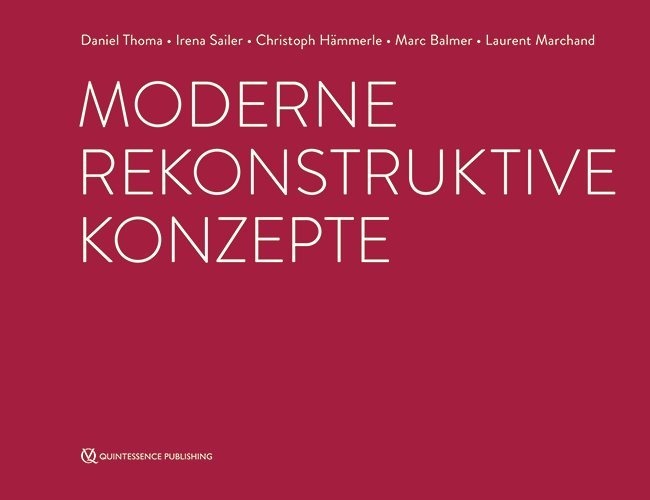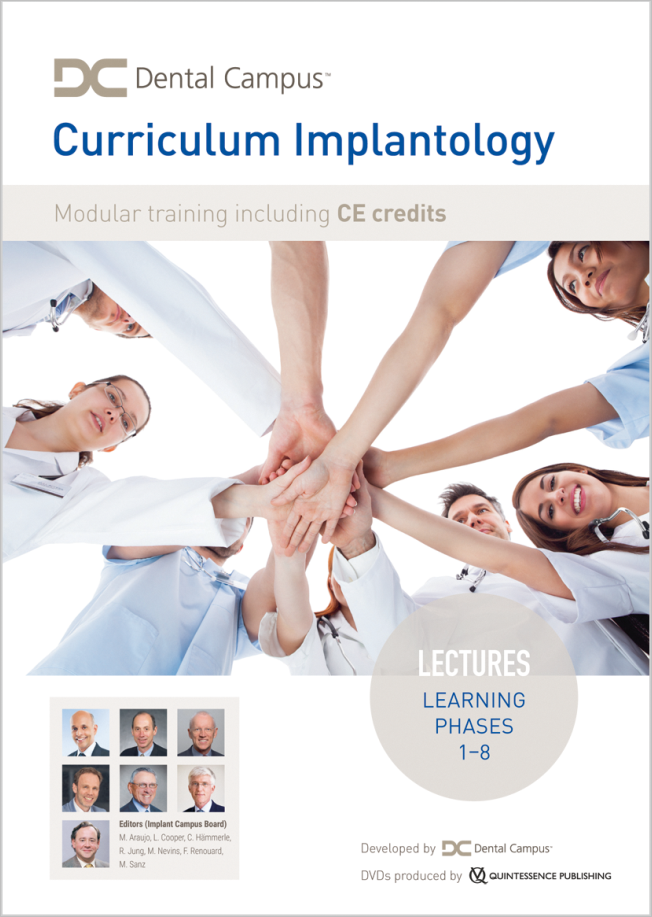The International Journal of Prosthodontics, 3/2024
DOI: 10.11607/ijp.8264, PubMed-ID: 37222706Seiten: 261-270, Sprache: EnglischErmatinger, Sarah / Lee, Wan-Zhen / Thoma, Daniel S./ Hüsler, Jürg / Hämmerle, Christoph H.F. / Naenni, NadjaPurpose: To assess the clinical concept of patient treatment with fixed tooth- and implant-supported restorations in a university-based undergraduate program after 13 to 15 years. Materials and Methods: In total, 30 patients (mean age 56 years) who had received multiple tooth- and implant-supported restorations were recalled after 13 to 15 years. The clinical assessment comprised biologic and technical parameters as well as patient satisfaction. Data were analyzed descriptively, and the 13- to 15-year survival rates for tooth- and implant-supported single crowns and fixed dental prostheses (FDPs) were calculated. Results: The survival rate of tooth-supported restorations amounted to 88.3% (single crowns) and 69.6% (FDPs); in implants, it reached 100% for all types of restorations. Overall, 92.4% of all restorations were free of technical complications. The most common technical complication was chipping of the veneering ceramic (tooth-supported restorations: 5.5%; implant-supported restorations: 13% to 15.9%) regardless of the material used. For tooth-supported restorations, increased probing depth ≥ 5 mm was the most frequent biologic complication (22.8%), followed by endodontic complications of root canal–treated teeth (14%) and loss of vitality at abutment teeth (8.2%). Peri-implantitis was diagnosed in 10.2% of implants. Conclusions: The results of this study indicate that the clinical concept implemented in the undergraduate program and performed by undergraduate students works well. The clinical outcomes are similar to those reported in the literature. In general, the majority of biologic complications occur in reconstructed teeth, whereas implant-supported restorations are more prone to technical complications.
The International Journal of Prosthodontics, 5/2023
DOI: 10.11607/ijp.7909, PubMed-ID: 36484663Seiten: 554-562, Sprache: EnglischKheur, Mohit / Lakha, Tabrez / Mühlemann, Sven / Hämmerle, Christoph H.F. / Haider, Afifuddin / Qamri, Batul / Kheur, SupriyaPurpose: To assess oral health–related quality of life (OHRQoL) and patient satisfaction with a three-implant-retained mandibular overdenture. Materials and Methods: In this randomized crossover clinical trial, 20 edentulous patients received a new set of conventional complete dentures (CDs; baseline). Subsequently, three implants were placed in the anterior mandible: two were placed in the canine regions bilaterally and one in the midline. After successful osseointegration, CDs were attached to the implants using resilient attachments. The overdenture was retained either by three implants (test group) or two implants (control group). The sequence of treatment was randomized such that each patient experienced both treatment options for 6 months each. OHRQoL was assessed at baseline and after 6 months of function for each treatment option using the Oral Health Impact Profile (OHIP-14) and visual analog scale (VAS) scores. Statistical analyses were performed using Friedman and Wilcoxon signed rank tests. Results: CD resulted in significantly higher OHIP-14 and VAS scores (25.25 + 6.42, 8.55 + 1.73) compared to both the control group (11.15 + 5.39, 4 + 2; P < .001) and the test group (6.25 + 4.02, 2.06 + 1.48; P < .001). Similarly, significantly higher mean OHIP-14 and VAS scores were noted for the control group compared to the test group (P < .001). Conclusions: Overdentures retained by three implants resulted in better OHRQoL scores and higher patient satisfaction compared to overdentures retained by two implants and CDs. Int J Prosthodont 2023;36:554–56
The International Journal of Prosthodontics, 4/2023
DOI: 10.11607/ijp.7907, PubMed-ID: 37699182Seiten: 416-425, Sprache: EnglischLakha, Tabrez / Kheur, Mohit / Hämmerle, Christoph / Kheur, Supriya / Qamri, BatulPurpose: To assess marginal bone loss (MBL) and implant stability when implant site preparation is performed with conventional drilling and the osteotome technique in the posterior maxilla. Materials and Methods: In total, 30 patients (mean age: 46.97 + 7.48 years) receiving 60 implants were enrolled in this study. In each patient, implant site preparation was done using either conventional drilling (conventional group; n = 30) or the osteotome technique (osteotome group; n = 30). The implant sites were further divided into groups based on the implant length used (implant length < 10 mm, implant length ≥ 10 mm). Marginal bone levels and implant stability quotient (ISQ) values were evaluated at the time of crown insertion and 1 year later. Independent t test and paired t test were used for intergroup and intragroup comparison, respectively. Results: The osteotome group showed statistically significant higher initial ISQ (ISQi) and final ISQ (ISQf) values (ISQi: 61 ± 3.6; ISQf: 64.08 ± 3.7) compared to the conventional group (ISQi: 58.01 ± 4.6; ISQf: 61.32 ± 4.8). Statistically significant higher mean MBL was noted in the conventional group (–0.33 ± 0.12 mm) compared to the osteotome group (–0.26 ± 0.10 mm). Higher MBL was noted in the osteotome group (–0.32 ± 0.09 mm) compared to the conventional group (–0.30 ± 0.14 mm) for implants shorter than 10 mm. For implants ≥ 10 mm in length, significantly higher MBL was noted in the conventional group (–0.37 ± 0.09 mm) compared to the osteotome group (–0.19 ± .06 mm). Conclusions: Osteotome technique could be used as an alternative to conventional drilling, especially when implants longer than 10 mm are planned in the posterior maxilla.
International Journal of Computerized Dentistry, 3/2023
ScienceDOI: 10.3290/j.ijcd.b3781703, PubMed-ID: 36632986Seiten: 237-245, Sprache: Englisch, DeutschGil, Alfonso / Eliades, George / Özcan, Mutlu / Jung, Ronald E. / Hämmerle, Christoph H. F. / Ioannidis, AlexisZiel: Untersuchung der Bruchlast und der Art der Fraktur von zwei verschiedenen monolithischen Restaurationsmaterialien, die auf standardisierte Titanbasen geklebt und hinsichtlich der Klebefläche mit zwei verschiedenen Verfahren hergestellt wurden.
Material und Methode: Alle Implantatkronen (n = 40), die einer Alterung durch thermomechanische Belastung unterzogen wurden, unterschieden sich hinsichtlich des Restaurationsmaterials (Lithiumdisilikat, LDS oder polymerinfiltriertes Keramiknetzwerk, PICN) und der Art der Schnittstelle zwischen Restaurationsmaterial und Titan-Basis (präfabriziert oder im CAM-Fräsverfahren hergestellt). Daraus ergaben sich folgende Gruppen (n = 10/Gruppe): (1) LDS-M: Lithiumdisilikat- Krone mit CAM-gefräster Schnittstelle, (2) LDS-P: Lithiumdisilikat-Krone mit präfabrizierter Schnittstelle, (3) HYC-M: PICN-Krone mit CAM-gefräster Schnittstelle und (4) HYC-P: PICN-Krone mit präfabrizierter Schnittstelle. Die gealterten Proben wurden einer statischen Bruchlastprüfung unterzogen. Die Belastung (N), bei der der erste Riss auftrat, wurde als Finitial bezeichnet und die maximale Belastung (N), bei der die Restaurationen brachen, als Fmax. Alle Proben wurden unter einem Mikroskop untersucht, um die Art der Fraktur zu bestimmen.
Ergebnisse: Die medianen Finitial-Werte betrugen 180 N für LDS-M, 343 N für LDS-P, 340 N für HYC-M und 190 N für HYC-P. Die medianen Fmax-Werte betrugen 1.822 N für LDS-M, 2.039 N für LDS-P, 1.454 N für HYC-M und 1.581 N für HYC-P. Die Unterschiede zwischen den Gruppen waren signifikant für Finitial (KW: p = 0,0042) und für Fmax (KW: p = 0,0010). Auch bei den Frakturtypen zeigten sich Unterschiede zwischen den Gruppen.
Schlussfolgerung: Die Wahl des Restaurationsmaterials hatte einen stärkeren Einfluss auf die Frakturbelastung als die Abutment-Schnittstelle. Lithiumdisilikat wies die höchste Belastung bis zur initialen Rissbildung (Finitial) und Bruchlast (Fmax) auf.
Schlagwörter: Lithiumdisilikat, Dentalwerkstoffe, polymerinfiltriertes Keramiknetzwerk, thermomechanische Alterung, Bruchlast, Versagensmodus, prothetische Zahnheilkunde, Restaurationsmaterial, Abutment-Schnittstelle
Quintessenz Zahnmedizin, 10/2023
ProthetikSeiten: 830-831, Sprache: DeutschHämmerle, ChristophRezensionThe International Journal of Prosthodontics, 5/2021
DOI: 10.11607/ijp.6999Seiten: 560-566d, Sprache: EnglischStucki, Lukas / Asgeirsson, Asgeir G / Jung, Ronald E / Sailer, Irena / Hämmerle, Christoph Hf / Thoma, Daniel SPurpose: To assess the clinical, technical, and esthetic outcomes of directly veneered zirconia abutments cemented onto nonoriginal titanium bases over a 3-year follow-up.
Materials and Methods: A total of 24 healthy patients with a single missing tooth in the maxilla or mandible (incisors, canines, or premolars) received a two-piece implant with a screw-retained veneered zirconia restoration extraorally cemented onto a titanium base abutment. Baseline measurements and follow-up examinations were performed at 6 months, 1 year, and 3 years following loading. Radiographic, clinical, technical, and esthetic parameters were assessed. Wilcoxon signed rank test was used to analyze the data.
Results: Mean marginal bone levels measured 0.54 ± 0.39 mm (median: 0.47 mm, range: 0.07 to 1.75 mm) at baseline and 0.52 ± 0.39 mm (median: 0.39 mm, range: 0.06 to 1.33 mm) at 3 years. Mean probing depth around the implants increased from 3.0 ± 0.6 mm at baseline to 3.8 ± 0.8 mm at 3 years (P = .001). Bleeding on probing changed from 27.1% ± 20.7% at baseline to 51.5% ± 26.1% at 3 years (P = .001). The mean plaque control record amounted to 11.1% ± 21.2% at baseline and 14.4% ± 13.89% at 3 years (P = .261). Two implants were lost at 3.5 and 30 months postloading due to periimplantitis, resulting in a 91.7% implant survival rate. Patient satisfaction was high at 3 years.
Conclusion: Zirconia restorations cemented onto the tested nonoriginal titanium bases should not be recommended for daily clinical use, as they were associated with significant increases in BOP and PD values and varying marginal bone levels 3 years after placement.
International Journal of Esthetic Dentistry (DE), 2/2021
Seiten: 156-157, Sprache: DeutschGil, Alfonso / Müller, Pascal / Hämmerle, Christoph / Jung, RonaldInternational Journal of Esthetic Dentistry (EN), 2/2021
PubMed-ID: 33969971Seiten: 142-143, Sprache: EnglischGil, Alfonso / Müller, Pascal / Hämmerle, Christoph / Jung, RonaldTeam-Journal, 1/2021
KOMPETENZ PLUSSeiten: 6-16, Sprache: DeutschFehmer, Vincent / Burkhardt, Felix / Sancho-Puchades, Manuel / Hämmerle, Christoph / Sailer, IrenaDie Diagnostik ist entscheidend für den vorhersagbaren Erfolg einer restaurativen Therapie. Hierbei müssen sich Patient und Zahnarzt vor der Anfertigung der definitiven Restauration auf ein gemeinsames Behandlungsziel einigen, um später Enttäuschungen zu vermeiden. Allerdings kann es schwierig sein, die Patientenwünsche vollständig zu erfassen. Ein nützliches Hilfsmittel zur Lösung dieses Problems sind das diagnostische Wax-up und Mock-up. Mit diesem zeitaufwendigen Verfahren wird jedoch nur eine einzige Variante des möglichen Behandlungsergebnisses visualisiert. Die moderne Digitaltechnik bietet nützliche Funktionen, die bei diesem diagnostischen Schritt zu einer Entscheidungsfindung beitragen können. Im vorliegende Beitrag werden die Möglichkeiten der Digitaltechnik für die prothetische Diagnostik erörtert und die Verfahren anhand von Patientenfällen beschrieben.
The International Journal of Prosthodontics, 1/2021
Seiten: 79-87, Sprache: EnglischMühlemann, Sven / Stromeyer, Sofia / Ioannidis, Alexis / Attin, Thomas / Hämmerle, Christoph HF / Özcan, MutluPurpose: To measure the effect of simulated aging on stained resin-ceramic CAD/CAM materials regarding the durability of color and gloss.
Materials and Methods: Test specimens (n = 15 per material) were prepared out of CAD/CAM ingots from two resin nanoceramics (Lava Ultimate [LVU], Cerasmart [CER]) and a polymerinfiltrated ceramic (ENA, VITA Enamic) stained with the manufacturer’s recommended staining kit using photopolymerization. Control specimens were made of feldspathic ceramic (VITA Mark II [VM2]) and stained by means of ceramic firing. Negative control specimens (n = 15) (no staining) were prepared for each group. Color and gloss measurements were performed before and after each aging cycle by means of mechanical abrasion with a toothbrush. Groups were compared using Kruskal-Wallis test and paired post hoc Conover test. Changes within a group were calculated using Wilcoxon signed-rank test (α = .05).
Results: The color difference (ΔE) was statistically significant for all stained CAD/CAM materials after simulated aging: CER (P < .001, 95% CI: 2.96 to 3.69), LVU (P = .004, 95% CI: 1.09 to 1.46), ENA (P = .004, 95% CI: 0.20 to 0.42), and VM2 (P < .001, 95% CI: 0.29 to 1.08). Aging resulted in a statistically significant increase in gloss in the LVU group (P < 0.001, 95% CI: 13.78 to 17.29), whereas in the ENA (P < .001, 95% CI: 7.83 to 12.72), CER (P < .001, 95% CI: 2.69 to 8.44), and VM2 (P = .014, 95% CI: 0.22 to 1.87) groups, a significant decrease in gloss was noted.
Conclusion: Color and gloss of stained resin-ceramic CAD/CAM materials changed significantly after aging by means of toothbrush abrasion in vitro.






